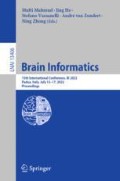Abstract
Feature importance is one of the most common explanations provided by Machine Learning (ML). However, different classification algorithms or different training sets could produce different rankings of predictive features. Thus, the quantification of differences between feature importance is crucial for assessing model trustworthiness. Rank-biased Overlap (RBO) is a similarity measure between incomplete, top-weighted and indefinite rankings, which are all characteristics of feature importance. In RBO, tuning persistence p allows to truncate rankings at any arbitrary depth, so to evaluate their overlapping size at increasing number of features. Classification of Parkinson’s disease (PD) with Explainable Boosting Machine (EBM) was chosen here as case study for introducing RBO in ML. An imbalanced dataset, 168 healthy controls (HC) and 396 PD patients, with 178 among clinical and imaging features was obtained from PPMI. Imbalanced, undersampled (K-Medoids) and oversampled (SMOTE) datasets were used for training EBMs, obtaining their respective feature importance. RBO score was calculated between ranking pairs incrementally increasing the depth by five features, from 1 to 178. All classifiers reached excellent AUC-ROC (~1) on test set, demonstrating the EBM prediction stability when trained on imbalanced datasets. RBO revealed that the maximum size of overlapping (80%) among rankings was obtained truncating at top 40 features, while their similarity decreased asymptotically to 50% when more than 45 features were considered. Thanks to RBO it was possible to demonstrate that, for the same accuracy, the more similar are the feature importance, the more stable is the model and the more reliable is the ML interpretability.
Access this chapter
Tax calculation will be finalised at checkout
Purchases are for personal use only
References
Molnar, C.: Interpretable machine learning. Lulu.com (2020)
Saarela, M., Jauhiainen, S.: Comparison of feature importance measures as explanations for classification models. SN Appl. Sci. 3(2), 1–12 (2021). https://doi.org/10.1007/s42452-021-04148-9
Webber, W., Moffat, A., Zobel, J.: A similarity measure for indefinite rankings. ACM Trans. Inform. Syst. 28, 1–38 (2010)
Sarica, A.: Editorial for the Special Issue on “Machine Learning in Healthcare and Biomedical Application”, MDPI, vol. 15, p. 97 (2022)
Dubey, R., Zhou, J., Wang, Y., Thompson, P.M., Ye, J.: Initiative AsDN: analysis of sampling techniques for imbalanced data: an n= 648 ADNI study. Neuroimage 87, 220–241 (2014)
Kendall, M.G.: Rank correlation methods (1948)
Yilmaz, E., Aslam, J.A., Robertson, S.: A new rank correlation coefficient for information retrieval. In: Proceedings of the 31st Annual International ACM SIGIR Conference on Research and Development in Information Retrieval, pp. 587–594 (2008)
Bar-Ilan, J., Mat-Hassan, M., Levene, M.: Methods for comparing rankings of search engine results. Comput. Netw. 50, 1448–1463 (2006)
Bar-Ilan, J.: Comparing rankings of search results on the web. Inf. Process. Manage. 41, 1511–1519 (2005)
Caruana, R., Lou, Y., Gehrke, J., Koch, P., Sturm, M., Elhadad, N: Intelligible models for healthcare: predicting pneumonia risk and hospital 30-day readmission. In: Proceedings of the 21th ACM SIGKDD International Conference on Knowledge Discovery and Data Mining, pp. 1721–1730 (2015)
Sarica, A., Quattrone, A., Quattrone, A.: Explainable boosting machine for predicting alzheimer’s disease from MRI hippocampal subfields. In: Mufti Mahmud, M., Kaiser, S., Vassanelli, S., Dai, Q., Zhong, N. (eds.) BI 2021. LNCS (LNAI), vol. 12960, pp. 341–350. Springer, Cham (2021). https://doi.org/10.1007/978-3-030-86993-9_31
Sarica, A., Quattrone, A., Quattrone, A.: Explainable machine learning with pairwise interactions for the classification of Parkinson’s disease and SWEDD from clinical and imaging features. Brain Imag. Behav. 1–11 (2022)
Park, H.-S., Jun, C.-H.: A simple and fast algorithm for K-medoids clustering. Expert Syst. Appl. 36, 3336–3341 (2009)
Chawla, N.V., Bowyer, K.W., Hall, L.O., Kegelmeyer, W.P.: SMOTE: synthetic minority over-sampling technique. J. Artific. Intell. Res. 16, 321–357 (2002)
Goetz, C.G., et al.: Movement disorder society URTF: movement disorder society-sponsored revision of the unified parkinson’s disease rating scale (MDS-UPDRS): scale presentation and clinimetric testing results. Mov. Disord. 23, 2129–2170 (2008)
Hastie, T.J., Tibshirani, R.J.: Generalized Additive Models. CRC Press (1990)
Lou, Y., Caruana, R., Gehrke, J., Hooker, G.: Accurate intelligible models with pairwise interactions. In: Proceedings of the 19th ACM SIGKDD International Conference on Knowledge Discovery and Data Mining, pp. 623–631 (2013)
Nori, H., Jenkins, S., Koch, P., Caruana, R.: Interpretml: A unified framework for machine learning interpretability. arXiv preprint arXiv:190909223 (2019)
Melucci, M.: Weighted rank correlation in information retrieval evaluation. In: Lee, G.G., et al. (eds.) Information Retrieval Technology, pp. 75–86. Springer, Heidelberg (2009). https://doi.org/10.1007/978-3-642-04769-5_7
Lou, Y., Caruana, R., Gehrke, J.: Intelligible models for classification and regression. In: Proceedings of the 18th ACM SIGKDD International Conference on Knowledge Discovery and Data Mining, pp. 150–158 (2012)
Breiman, L.: Statistical modeling: the two cultures (with comments and a rejoinder by the author). Stat. Sci. 16, 199–231 (2001)
Jollans, L., et al.: Quantifying performance of machine learning methods for neuroimaging data. Neuroimage 199, 351–365 (2019)
Patil, A., Framewala, A., Kazi, F.: Explainability of smote based oversampling for imbalanced dataset problems. In: 2020 3rd International Conference on Information and Computer Technologies (ICICT), pp. 41–45. IEEE (2020)
Sarica, A., Cerasa, A., Quattrone, A.: Random forest algorithm for the classification of neuroimaging data in Alzheimer’s disease: a systematic review. Front. Aging Neurosci. 9, 329 (2017)
Author information
Authors and Affiliations
Corresponding author
Editor information
Editors and Affiliations
Rights and permissions
Copyright information
© 2022 Springer Nature Switzerland AG
About this paper
Cite this paper
Sarica, A., Quattrone, A., Quattrone, A. (2022). Introducing the Rank-Biased Overlap as Similarity Measure for Feature Importance in Explainable Machine Learning: A Case Study on Parkinson’s Disease. In: Mahmud, M., He, J., Vassanelli, S., van Zundert, A., Zhong, N. (eds) Brain Informatics. BI 2022. Lecture Notes in Computer Science(), vol 13406. Springer, Cham. https://doi.org/10.1007/978-3-031-15037-1_11
Download citation
DOI: https://doi.org/10.1007/978-3-031-15037-1_11
Published:
Publisher Name: Springer, Cham
Print ISBN: 978-3-031-15036-4
Online ISBN: 978-3-031-15037-1
eBook Packages: Computer ScienceComputer Science (R0)

